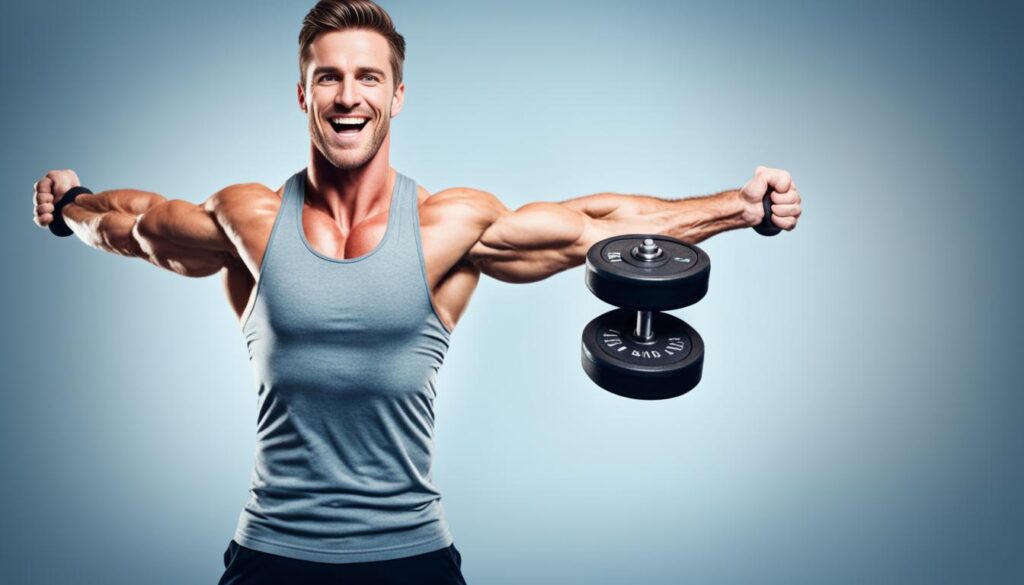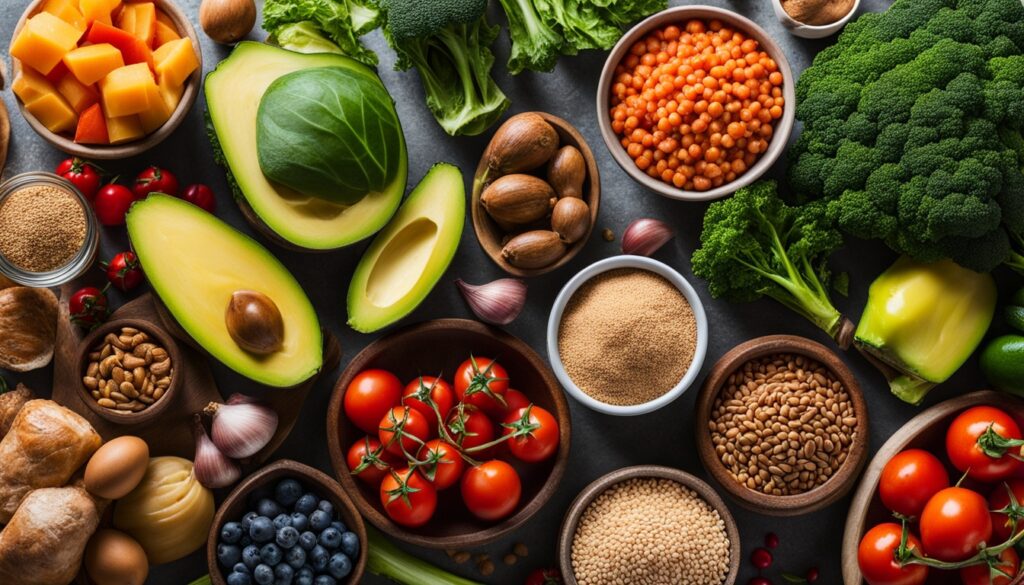Can you really have your cake and eat it too when it comes to fitness goals? The idea of simultaneously building muscle and losing fat may seem like an unrealistic pipe dream, but it is, in fact, an achievable goal known as body recomposition1. However, this undertaking requires a strategic approach and a deep understanding of the physiological processes involved. In this comprehensive guide, we’ll explore the challenges, benefits, and proven strategies to help you unlock the secrets to successful body recomposition.
Key Takeaways
- Body recomposition involves changing the ratio of fat mass to lean mass, simultaneously losing body fat and gaining muscle mass1
- Successful body recomposition requires a combination of cardiovascular exercise, resistance training, decreased calorie consumption, and increased protein intake1
- High-protein diets can aid in losing fat and gaining muscle simultaneously during a calorie deficit1
- Calorie cycling, where calorie and macronutrient intake is adjusted based on activity levels, can be an effective approach1
- Body recomposition requires long-term commitment as it combines the goals of losing fat and gaining muscle1
Introduction to Body Recomposition
What is Body Recomposition?
Body recomposition, a concept that has gained significant attention in the fitness world, refers to the simultaneous process of gaining muscle and losing fat2. This is a challenging goal because muscle gain and fat loss are often considered contradictory physiological processes. Gaining muscle typically requires a calorie surplus, while losing fat necessitates a calorie deficit3.
The Challenges of Gaining Muscle and Losing Fat
Achieving body recomposition can be a complex and nuanced endeavor2. Research indicates that certain individuals are more likely to succeed in this pursuit, including beginner lifters, detrained individuals, those with higher body fat percentages (e.g., over 25%), and those who have not been consistent with training or nutrition2. The body may resist doing both at the same time, especially if the primary focus is on weight loss3. Developing a detailed plan that considers both fat loss and muscle gain, with input from professionals, is crucial for successful body recomposition.
Ultimately, body recomposition requires a delicate balance of nutrition, training, and lifestyle factors. By understanding the challenges and implementing a well-designed approach, individuals can embark on their journey to simultaneously build muscle and shed fat.
Benefits of Gaining Muscle
Building muscle offers a wealth of advantages that can positively impact your overall health and well-being. Increased muscle mass not only enhances your strength and endurance but also reduces the risk of injuries or falls4. Maintaining a healthy muscle-to-fat ratio can lead to better blood sugar and cholesterol levels, boosting your heart health and functional abilities5. Additionally, stronger muscles improve coordination and balance, contributing to a decreased risk of chronic conditions like diabetes, cancer, and heart disease5.
Muscle-building also has a significant impact on your body composition. By increasing your muscle mass, you can boost your resting metabolic rate, enabling you to burn more calories even at rest5. This, in turn, makes it easier to achieve and maintain a healthy weight, ultimately improving your overall fitness and quality of life.
- Improved strength and endurance
- Reduced risk of injuries or falls
- Better blood sugar and cholesterol levels
- Increased functional abilities and coordination
- Boosted heart health
- Improved bone density
- Decreased body fat
Maintaining and building muscle can have a profound impact on your physical and mental well-being. By prioritizing muscle development through a balanced diet and targeted resistance training, you can unlock a wide range of benefits that will enhance your overall health and fitness6.
“Muscle is the engine of the body, and the more muscle you have, the more efficient your engine will be. Muscle is the key to a healthier, more functional, and more active life.”
Remember, building muscle is a journey, and with patience, consistency, and the right approach, you can achieve remarkable results that will benefit you both physically and mentally6.
Benefits of Losing Body Fat
Shedding excess body fat can have a profound impact on your overall health and well-being. Losing body fat and reducing your weight can lead to a variety of beneficial outcomes, including improved blood sugar control, reduced blood pressure, better cholesterol levels, more regular menstrual cycles, enhanced joint mobility, and a decreased risk of depression7.
Even modest weight loss of 5% to 10% of your total body weight can result in significant positive changes7. Decreased body fat can also contribute to improved sexual function, reduced risk of sleep apnea, enhanced heart health, and a lower chance of experiencing a stroke7.
Health Advantages of Fat Loss
- Improved blood sugar control and reduced risk of type 2 diabetes
- Lower blood pressure and reduced risk of hypertension
- Better cholesterol measurements and decreased risk of heart disease
- More regular and consistent menstrual cycles for women
- Enhanced joint mobility and reduced pain or discomfort
- Decreased risk of depression and improved mental well-being
- Reduced issues with urinary incontinence
- Improved sexual function and libido
- Lower risk of sleep apnea and better sleep quality
- Reduced risk of stroke and enhanced cardiovascular health
The advantages of losing body fat and reducing your overall weight are numerous and far-reaching. By shedding excess fat, you can experience a wide range of health improvements that can positively impact your quality of life.7
“Even losing as little as 5% to 10% of your body weight can have significant positive effects on your overall health.”7
The key is to approach fat loss in a sustainable and healthy manner, focusing on a balanced diet, regular exercise, and lifestyle modifications that promote long-term well-being8. By doing so, you can enjoy the numerous benefits of fat loss, including the advantages of reduced body fat and the health improvements that come with weight loss.789
Is It Possible to Build Muscle and Lose Fat Simultaneously?
The short answer is yes, it is possible to build muscle and lose fat simultaneously, a process known as body recomposition10. However, there are times when people lose body fat and also lose muscle, which is referred to as weight-loss–induced muscle loss11. This can result in reduced muscle function and loss of strength. To avoid this, experts recommend accompanying your weight loss efforts with a consistent resistance training program and other forms of exercise, as well as balancing your nutrition with your exercise routine12.
Research has shown that men eating in a 40% energy deficit for four weeks while resistance training were able to increase their lean body mass10. Similarly, women who did resistance training and ate a high-protein diet simultaneously lost fat and built muscle10. The key is to focus on compound movements like squats, deadlifts, presses, and rows to stimulate the most total muscle mass possible, aiming for 5-8 reps per set for muscle gain12.
To achieve successful body recomposition and see results in both muscle gain and fat loss, it’s important to maintain a gradual weight loss of 1 to 2 pounds per week to ensure that most of the lost weight is fat rather than muscle11. Additionally, incorporating high-intensity interval training (HIIT) 1-3 times per week has been shown to preserve muscle mass and enhance fat use as fuel efficiently12.
With consistency and a balanced approach to nutrition and exercise, you can gain muscle and lose fat at the same time. The key is to be patient and persistent, as the process of body recomposition can take time to achieve the desired results10.

“Proper protein intake while sustaining a caloric deficit can help the body burn more calories than consumed.”11
The Importance of Protein
Protein is the most critical nutrient for those seeking to build muscle and lose fat simultaneously through body recomposition13. An adequate protein intake helps construct new muscle tissue and prevents your body from utilizing existing muscle as fuel during workouts13. Experts recommend that a minimum of 35% of your daily calorie intake should come from protein to support weight loss, and at least 3 grams of protein per kilogram of body weight to encourage muscle gain and fat loss13.
Quality Protein Sources
Selecting high-quality protein sources is essential for effective body recomposition. Some of the best protein-rich foods include poultry, lean meats, fish, eggs, dairy, legumes, nuts, and seeds13. Incorporating a variety of these nutrient-dense protein sources into your diet can help you meet your protein needs and support your muscle-building and fat-loss goals13.
Optimal Protein Intake for Body Recomposition
The recommended protein intake for individuals seeking to build muscle and lose fat simultaneously is between 1 to 1.4 grams of protein per pound of body weight14. This elevated protein intake can help maintain existing muscle mass while in a calorie deficit for fat loss, and also support the growth of new muscle tissue14. However, it’s essential to speak with a healthcare provider before significantly increasing your protein intake, as excessive protein consumption or an imbalance in macronutrients may worsen certain health conditions13.
“Protein intake is crucial for both losing body fat and building muscle simultaneously. Incorporating a variety of high-quality protein sources into your diet can help you achieve your body recomposition goals.”
Resistance Training for Muscle Gain and Fat Loss
Resistance training is a crucial component of any effective body recomposition program. By exercising the muscles against external resistance, such as using weights, resistance bands, or bodyweight exercises, you can stimulate muscle growth and enhance fat-burning capabilities15. The key is to perform reps to the point of muscle fatigue, engaging the maximum number of muscle fibers and promoting both muscle development and improved insulin sensitivity, which supports fat loss15.
Effective Resistance Training Techniques
To maximize the benefits of resistance training for body recomposition, focus on incorporating a variety of effective techniques. Multi-joint exercises like the bench press, deadlift, and squat are particularly effective, as they engage multiple muscle groups simultaneously and stimulate greater muscle activation16. Single-joint exercises like bicep curls and calf raises can also be valuable for targeting specific muscle groups and promoting overall muscle development.
When it comes to program design, aim for a rep range of 5-8 reps per set, using challenging weights that lead to muscle fatigue12. Gradually increase the weight lifted over time to continually challenge your muscles and drive muscle growth. Incorporating both high-intensity and high-volume training can help maximize the benefits of resistance training for body recomposition.
Compound exercises that work multiple muscle groups, such as squats, deadlifts, and pull-ups, are especially effective for building lean muscle mass and supporting fat loss12. By focusing on these compound movements, you’ll be able to engage a larger number of muscle fibers, leading to greater muscle activation and increased metabolic rate.
Remember, consistency is key when it comes to resistance training for body recomposition. Aim to incorporate resistance training into your routine 3-4 times per week, allowing for adequate rest and recovery between sessions. This balanced approach will help you maximize the benefits of resistance training and achieve your body recomposition goals151612.
Cardio and Other Exercises for Fat Loss
In addition to resistance training, incorporating other forms of physical activity can be highly beneficial for fat loss. While resistance training helps build muscle, experts recommend balancing it with exercises that don’t hinder muscle recovery, as the body needs adequate time to repair and grow between strength training sessions17.
Some excellent options for complementary exercises that can support fat loss include walking, running, cycling, swimming, yoga, and high-intensity interval training (HIIT). These activities can help create a calorie deficit, which is crucial for shedding excess body fat17.
- Walking is a low-impact, moderate-intensity cardio exercise that offers health benefits without a high injury risk17.
- Running and cycling are more intense forms of cardio that can burn a significant number of calories, but they require more recovery time between sessions17.
- Swimming is a great low-impact option that works the entire body and can be especially beneficial for individuals with joint issues17.
- Yoga and Pilates are gentle, restorative exercises that can improve flexibility, balance, and mindfulness, which can support overall well-being and fat loss17.
- HIIT workouts, which involve short bursts of intense exercise followed by periods of rest, have been shown to be more effective for fat loss compared to steady-state cardio17.
By incorporating a mix of resistance training and these other exercises, you can create a comprehensive workout routine that supports both muscle gain and fat loss, a process known as body recomposition17.
| Exercise | Benefits for Fat Loss |
|---|---|
| Walking | Low-impact, moderate-intensity cardio that can burn calories without high injury risk17 |
| Running | High-intensity cardio that can burn a significant number of calories, but requires more recovery time17 |
| Cycling | High-intensity cardio that can burn a significant number of calories, but requires more recovery time17 |
| Swimming | Low-impact exercise that works the entire body, beneficial for individuals with joint issues17 |
| Yoga and Pilates | Gentle, restorative exercises that can improve flexibility, balance, and mindfulness to support overall well-being and fat loss17 |
| HIIT | Short bursts of intense exercise followed by periods of rest, more effective for fat loss compared to steady-state cardio17 |
By incorporating a balance of resistance training and these other forms of exercise, you can create a comprehensive workout routine that supports both muscle gain and fat loss, a process known as body recomposition17.
“Combining cardio and strength training into one workout can provide a comprehensive approach for weight loss.”17
Remember, the key is to find a balance that allows your body to recover and adapt, ensuring you can consistently maintain your workout routine for long-term success.
How to Build Muscle and Lose Fat Simultaneously
Achieving the elusive goal of building muscle and losing fat at the same time, known as body recomposition, requires a strategic approach. The key lies in creating a calorie deficit while ensuring adequate protein intake and resistance training18.
Creating a Calorie Deficit
To lose fat, you need to be in a calorie deficit, where you consume fewer calories than your body burns. This can be achieved by making small, sustainable adjustments to your diet, such as reducing your calorie intake by 500-1,000 calories per day18. However, it’s crucial to avoid drastic calorie cuts, as that can lead to muscle loss and negatively impact your metabolism4.
Nutrient-Dense Foods for Fat Loss
While in a calorie deficit, focus on consuming nutrient-dense, whole foods that are high in protein, fiber, and healthy fats. These foods not only support fat loss but also provide the necessary nutrients for muscle growth and maintenance4. Examples include lean proteins (such as chicken, fish, and eggs), vegetables, fruits, whole grains, and healthy fats (like avocado, nuts, and olive oil).
| Nutrient-Dense Foods for Fat Loss and Muscle Gain | Nutrient Profile |
|---|---|
| Lean Chicken Breast | High in Protein, Low in Fat |
| Salmon | High in Protein, Omega-3 Fatty Acids |
| Eggs | High in Protein, Vitamins, and Minerals |
| Broccoli | High in Fiber, Vitamins, and Minerals |
| Sweet Potatoes | High in Fiber, Vitamins, and Complex Carbs |
| Avocado | High in Healthy Fats, Fiber, and Vitamins |
Incorporating these nutrient-rich foods into your diet will help support your body recomposition goals while providing the necessary fuel for your workouts and recovery4.

“Slow and steady fat loss is preferable when aiming to build muscle, as losing weight quickly can lead to muscle loss.”18
By creating a moderate calorie deficit and focusing on nutrient-dense foods, you can effectively lose fat while maintaining and even building muscle18. Remember, patience and consistency are key to achieving sustainable body recomposition results18194.
Sleep and Recovery for Optimal Results
Achieving successful body recomposition, the process of simultaneously building muscle and losing fat, hinges on the importance of sleep and recovery20. Adequate rest is crucial for your body to repair and rebuild muscle tissue, which is essential for muscle growth20. Additionally, taking periods of rest, such as complete rest days or low-impact cardio days, prevents overtraining and injury, allowing your muscles to recover properly between resistance training sessions.
Prioritizing sleep and recovery is essential for supporting your body’s ability to build muscle and shed fat simultaneously. Experts recommend getting 7-9 hours of sleep per night to ensure your body has the necessary time to repair and rebuild20. Additionally, maintaining a regular sleep schedule and practicing good sleep hygiene, such as avoiding screens before bed and creating a calm, comfortable sleep environment, can further optimize your body’s recovery processes.
Beyond sleep, incorporating active recovery activities, such as light cardio, stretching, or foam rolling, can also aid in the recovery process20. These low-impact exercises help improve blood flow, reduce muscle soreness, and prepare your body for the next challenging workout. By striking the right balance between intense training and adequate recovery, you can create an environment that supports both muscle growth and fat loss.
“Proper sleep and recovery are essential for the body’s ability to build muscle and shed fat simultaneously. Neglecting this aspect of the process can hinder your progress and increase the risk of injury.”
Remember, the importance of sleep for body recomposition cannot be overstated. Prioritizing your rest and recovery is just as crucial as your training and nutrition efforts. By ensuring your body has the time and resources it needs to repair and rebuild, you’ll maximize your chances of achieving your muscle-building and fat-loss goals.
In addition to sleep, proper recovery for muscle growth and fat loss also plays a vital role in your body recomposition journey. Incorporating active recovery activities, such as light cardio, stretching, or foam rolling, can help improve blood flow, reduce muscle soreness, and prepare your body for the next challenging workout20. By striking the right balance between intense training and adequate recovery, you can create an environment that supports both muscle growth and fat loss.
Lifestyle Factors for Body Recomposition
Achieving successful body recomposition, the process of simultaneously building muscle and losing fat, requires more than just optimized nutrition and exercise. Equally important are various lifestyle habits that can support your transformation goals21.
Hydration and Body Recomposition
Proper hydration is essential for body recomposition, as muscle tissue is composed of approximately 75% water21. Drinking adequate amounts of water, such as 16 ounces before and after a workout, in addition to your regular fluid intake, can enhance the delivery of nutrients to working and recovering muscles, as well as help remove waste products21. Additionally, practices like intermittent fasting may support body recomposition by increasing insulin sensitivity and promoting fat burning, though more research is needed21.
Beyond hydration, other lifestyle factors like quality sleep, stress management, and active recovery can also contribute to successful body recomposition. A holistic approach that addresses these elements, in conjunction with a well-structured nutrition and exercise plan, can optimize your results21.
| Lifestyle Factor | Importance for Body Recomposition |
|---|---|
| Hydration | Enhances nutrient delivery and waste removal, composing 75% of muscle tissue. |
| Sleep | Supports muscle recovery, hormone regulation, and overall metabolic health. |
| Stress Management | Helps maintain optimal cortisol levels, preventing muscle breakdown and fat storage. |
| Active Recovery | Promotes blood flow, reduces inflammation, and enhances muscle repair. |
By addressing these lifestyle factors in addition to your nutrition and training program, you can create a well-rounded approach to optimize your body recomposition journey21.

“Proper hydration is essential for muscle growth and fat loss, as water makes up the majority of our muscle tissue.”
Ultimately, a comprehensive strategy that considers not just diet and exercise, but also lifestyle habits like hydration, can lead to sustainable and transformative body recomposition results21.
Patience and Consistency for Long-Term Success
Achieving body recomposition, the simultaneous process of building muscle and losing fat, requires immense patience and unwavering consistency22. While the prospect of transforming your physique may seem alluring, the reality is that this approach is challenging for the vast majority of individuals22. Only a select few categories of people, such as fat beginners, those regaining lost muscle, genetic freaks, and those using steroids or drugs, have a realistic chance of successfully building muscle and losing fat at the same time22.
For the average person, the likelihood of simultaneous muscle gain and fat loss is slim to none22. Claims that it’s possible to achieve this feat are often associated with marketing strategies designed to sell products, or they may stem from a lack of accurate knowledge about the topic22. This Dunning-Kruger effect, where individuals with limited understanding overestimate their abilities, can lead to the propagation of misinformation22.
The key to successful body recomposition lies in patience and consistency23. Aim for a moderate caloric deficit of 500 calories per day to begin losing fat while enabling muscle growth23. Consume 1.6 to 2.2 grams of protein per kilogram of body weight to support muscle synthesis and repair23. Incorporate strength training three to four times per week with gradual weight and intensity increases to promote muscle development23. Additionally, include low-intensity steady-state (LISS) cardio or high-intensity interval training (HIIT) sessions 1-2 times per week to aid in fat loss23. Ensure you get 7-9 hours of sleep per night to support muscle healing and control hunger-related hormones23.
Consistency and patience are vital for body recomposition success, as progress may be slow but leads to lasting changes23. Monitor your progress through body composition measurements, progress images, and body fat percentage evaluations23. Remember, the journey towards a transformed physique requires dedication and a long-term mindset24. By focusing on your nutrition, training, and recovery, you can create a sustainable path to achieve your body recomposition goals24.
“Consistency in protein intake, adequate nutrition, training, patience, and trust in the process are essential for long-term success in body transformation goals.”24
| Metric | Recommendation |
|---|---|
| Calorie Intake | |
| Protein Intake | 1.6 to 2.2 grams of protein per kilogram of body weight to support muscle synthesis and repair23 |
| Strength Training | 3-4 times per week with gradual weight and intensity increases to promote muscle growth23 |
| Cardio | |
| Sleep | 7-9 hours per night to aid muscle healing and control hunger-related hormones23 |
| Progress Tracking |
In summary, the journey towards body recomposition, where you build muscle and lose fat simultaneously, requires immense patience and unwavering consistency22. While the prospect may seem appealing, the reality is that this approach is challenging for the majority of individuals22. However, by following a balanced and disciplined approach, focusing on your nutrition, training, and recovery, you can create a sustainable path to achieve your body transformation goals2324.
Conclusion
Body recomposition, the process of simultaneously gaining muscle and losing fat, is a challenging but achievable goal with the right approach. Studies have shown that it is possible for individuals of all ages and fitness levels to successfully lose fat and build muscle at the same time, even with just endurance training25. This includes overweight police officers who gained 8.8 pounds of lean body mass while losing 9.3 pounds of fat in just 12 weeks25, as well as elderly individuals who gained around 4 pounds of lean muscle mass while losing a similar amount of fat in 12 to 16 weeks25.
By focusing on resistance training, consuming adequate protein26, creating a sustainable calorie deficit26, and prioritizing lifestyle factors like sleep and hydration, you can successfully build muscle and lose fat at the same time. Research has even shown that body recomposition is possible in resistance-trained individuals, not just in untrained or overweight populations25. However, it’s important to approach this process with patience and consistency, as body recomposition takes time to see results27.
With a well-rounded plan and dedication to your fitness goals, you can achieve the body transformation you desire. By following the key takeaways for muscle gain and fat loss, you’ll be on your way to a healthier, more toned physique. Remember, consistency is key, and with the right approach, building muscle and losing fat simultaneously is27.
FAQ
What is body recomposition?
What are the benefits of gaining muscle?
What are the benefits of losing body fat?
Is it possible to build muscle and lose fat simultaneously?
What is the role of protein in body recomposition?
How does resistance training contribute to body recomposition?
What other exercises can support fat loss during body recomposition?
How can you successfully build muscle and lose fat simultaneously?
Why is sleep and recovery important for body recomposition?
What other lifestyle factors can impact body recomposition?
How long does it take to achieve body recomposition?
Source Links
- Yes, You Can Lose Weight and Gain Lean Muscle at the Same Time With This Strategy
- How To Lose Fat And Build Muscle At The Same Time (3 Simple Steps)
- What’s All the Buzz About ‘Body Recomposition’?
- The Best Way to Lose Fat and Gain Muscle At the Same Time
- Body Recomposition: Lose Fat and Gain Muscle at the Same Time
- How To Lose Fat And Gain Muscle At The Same Time
- Can You Lose Fat and Gain Muscle at the Same Time? | Ideal Nutrition
- Health Experts Share How They Help Clients Lose Fat And Gain Muscle At The Same Time
- Weight Loss Tips: Try this way to lose weight and gain muscle at the same time
- I want to lose fat, but I also want to build muscle. How should I eat and work out to achieve both goals at the same time?
- Can You Burn Fat and Gain Muscle at the Same Time? | Banner
- How to Burn Fat While Building Muscle
- Can You Actually Burn Fat and Gain Muscle at the Same Time?
- How to Build Muscle and Lose Fat at the Same Time
- Build Muscle and Burn Fat at the Same Time
- 8-Week Body Recomposition Guide: Lose Fat & Gain Muscle (2024)
- Pairing Cardio and Strength Training for Maximum Fat Loss
- Building Muscle While Losing Fat Is Possible, With These CPT- and Science-Backed Strategies
- How to Lose Fat and Gain Muscle at the Same Time
- How to Lose Fat and Build Muscle at the Same Time | Healthy Keto™ Dr. Berg
- Body Recomposition Macros: Lose Fat and Gain Muscle
- How To Build Muscle And Lose Fat At The Same Time: Can It Be Done?
- How to Lose Fat and Gain Muscle at the Same Time
- How to Burn Fat While Building Muscle || Body Recompositioning 101 – Heidi Powell
- Can you gain muscle and lose fat at the same time?
- Can you Build Muscle and Lose Fat at the Same Time
- Build Muscle And Lose Fat Simultaneously: Yes, It Is Possible!



